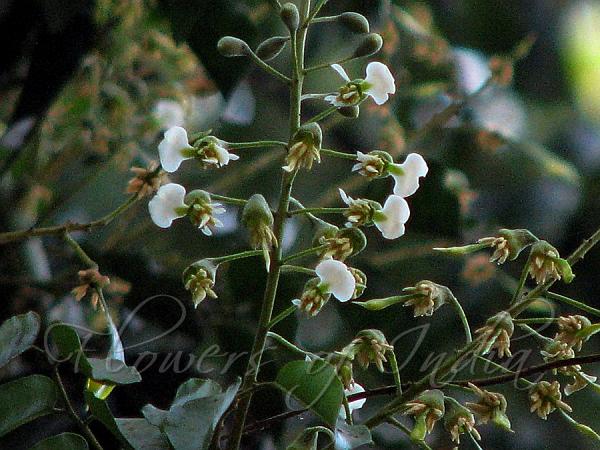|
| Peru Balsam |
|

|

| File size | 189668 |
| Original date | |
| Resolution | 0 x 0 |
| Flash | Flash did not fire, auto |
| Focal length | 71.9mm |
| Exposure time | 1/320s |
| Aperture | 4.5 |
| Focus Distance | |
| Metering Mode | Multi-segment |
| Camera make | Canon |
| Camera model | Canon PowerShot S5 IS |
| Sensor type | OneChipColorArea |
|
|
|
|
Photo: |
Botanical name: Myroxylon balsamum Family: Fabaceae (Pea family)
Synonyms: Toluifera balsamum, Myroxylon toluiferum
Synonyms: Toluifera balsamum, Myroxylon toluiferum
Peru Balsam is a large and beautiful tree with a
valuable wood like mahogany, and a straight smooth trunk. Trunk is
coarse grey, compact, heavy granulated and a pale straw colour,
containing a resin which changes from citron to dark brown, smell and
taste balsamic and aromatic. Leaves are alternately arranged, oddly
pinnate, leaflets 3-11, mostly opposite, ovate, lanceolate with the end
blunt emarginate. Flowers are whitish, corolla 5-petalled. The flowers
have a fragrance which can be smelt a hundred yards away. Every part
of the tree including the leaves abounds in a resinous juice. The
mesocarp of the fruit is fibrous, and the balsamic juice which is
abundant is contained in two distinct receptacles, one on each side.
The beans contain Coumarin, the husks an extremely acrid bitter resin,
and a volatile oil; a gum resin, quite distinct from the proper balsam,
exudes from the trunk of the tree and contains gum resin and a volatile
oil; the tree commences to be productive after five or six years, and
continues to yield for thirty years. The tree is well known for its
yield of balsam used in perfumes, harvested mainly in El Salvador.
Peru Balsam is found in a wide range from southern Mexico southward
through Central American and continuing to Argentina.
Medicinal uses:  Used in scabies and skin diseases; it destroys the itch acarus and its
eggs, and is much to be preferred to sulphur ointment, also of value in
prurigo, pruritis and in later stages of acute eczema. It is a good
antiseptic expectorant and a stimulant to the heart, increasing blood
pressure; its action resembles benzoic acid. It is applied externally
to sore nipples and discharges from the ear.
Used in scabies and skin diseases; it destroys the itch acarus and its
eggs, and is much to be preferred to sulphur ointment, also of value in
prurigo, pruritis and in later stages of acute eczema. It is a good
antiseptic expectorant and a stimulant to the heart, increasing blood
pressure; its action resembles benzoic acid. It is applied externally
to sore nipples and discharges from the ear.
 Used in scabies and skin diseases; it destroys the itch acarus and its
eggs, and is much to be preferred to sulphur ointment, also of value in
prurigo, pruritis and in later stages of acute eczema. It is a good
antiseptic expectorant and a stimulant to the heart, increasing blood
pressure; its action resembles benzoic acid. It is applied externally
to sore nipples and discharges from the ear.
Used in scabies and skin diseases; it destroys the itch acarus and its
eggs, and is much to be preferred to sulphur ointment, also of value in
prurigo, pruritis and in later stages of acute eczema. It is a good
antiseptic expectorant and a stimulant to the heart, increasing blood
pressure; its action resembles benzoic acid. It is applied externally
to sore nipples and discharges from the ear. | Identification credit: Viplav Gangar | Photographed in Mumbai, Maharashtra. |
• Is this flower misidentified? If yes,